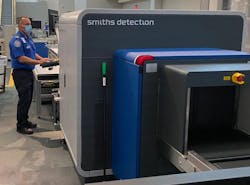TSA approaches industry for open-systems passenger- and baggage screening technologies for airport security
SPRINGFIELD, Va. – U.S. airport security technologies like passenger- and baggage-screening systems are heading toward open-systems architecture designs, leading federal authorities to ask for industry input on this subject.
Officials of the Transportation Security Administration (TSA) in Springfield, Va., have issued a request for information (70T04023I7573N001) for the Open Architecture Implementation project.
TSA leaders are reaching out to industry to find companies able to provide open-systems designs for airport security technologies such as detection algorithms, user interfaces, and reporting systems that could help TSA adopt state-of-the-art enabling technologies quickly to counter emerging threats and share information in real-time across distributed screening systems.
TSA’s mission is to protect the nation’s transportation systems from would-be terrorists, computer hackers, and similar threats by implementing a connected transportation security system of systems able to adopt state-of-the-art technologies quickly into a dynamic screening environment.
The key to achieving TSA’s vision is an open-architecture design approach where components, interfaces, and data formats are standards-based and interoperable, TSA officials say.
TSA has defined several ways to implement open architectures for connected transportation security systems, and agency officials would like comments from industry on project feasibility and costs for each of them.
Common data formats and interfaces are expected to facilitate technology interoperability. One example is the TSA's Digital Imaging and Communications in Security (DICOS) standardized data format (DICOS v3.0+) for capturing data and presenting it in a non-proprietary format.
A similar example is the TSA's Open Platform Software Library (OPSL), which standardizes data exchanges within systems to communicate mission data between system components.
New approaches to data accessibility are expected to establish a dataset able to capitalize on industry advancements in artificial intelligence (AI) and machine learning for up-front data collection and management.
Related: TSA eyes open-systems explosives detection for rapid airport security upgrades
Stream of commerce and threat data collection efficiently compiles and documents passenger baggage images and associated metadata in an efficient manner.
The passenger baggage object database will store and catalog threat and stream of commerce data in DICOS format in a data repository to support sharing with industry and government test facilities.A common workstation will help standardize the physical and graphical user interface across screening systems to reduce training, certification, and complexity for the officers.
The threat recognition system will combine computing hardware, OPSL, and DICOS to support interoperable screening equipment while decoupling the algorithm and common workstation through vendor-neutral application programming interfaces (APIs) and communications protocols.
Open-systems that TSA has accomplished to date include publishing the DICOS v3.0 standard and toolkits together with the National Electrical Manufacturer’s Association (NEMA); releasing the initial version of the OPSL software development kit; and completing threat-recognition system design reviews and prototype development to enable future laboratory and field demonstrations.
From industry, TSA officials are seeking feedback to help guide the next steps for standardized data formats and interfaces, including how to make source code available to industry.
Companies interested in providing feedback should email responses by 30 Sept. 2023 to the TSA's Siobhan Mullen at [email protected] and Siobhan Lawson at siobhan.lawson@tsa,dhs.gov.
Email questions or concerns to the TSA's Siobhan Mullen at [email protected] and Siobhan Lawson at siobhan.lawson@tsa,dhs.gov. More information is online at https://sam.gov/opp/7fb2aacbd5584e6eb8c8ad0c163d9eee/view.
About the Author
John Keller
Editor-in-Chief
John Keller is the Editor-in-Chief, Military & Aerospace Electronics Magazine--provides extensive coverage and analysis of enabling electronics and optoelectronic technologies in military, space and commercial aviation applications. John has been a member of the Military & Aerospace Electronics staff since 1989 and chief editor since 1995.
